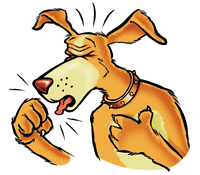
Bugsy, our 10 year-old Chihuahua , has been coughing for the past few months whenever he gets really excited. He was diagnosed with a collapsing trachea. What does this mean and what are my options? “
The trachea, commonly known as the windpipe, is the tube that connects the nose, mouth and throat to the lungs. This tube is supported by a series of small “C-shaped” rings made of cartilage. These cartilage rings wrap about 5/6th of the way around the circumference of the trachea, providing structural support to keep the tracheal tube open. A thin layer of muscle, known as the tracheal membrane, completes the circle around the trachea.
If the cartilage rings become weakened, the trachea loses this rigid support. Without support, the “C” loses its shape and starts to flatten out. As a result of the loss of “C” curvature, the tracheal membrane becomes loose and saggy. This process is known as tracheal collapse.
The areas of collapsed trachea can be located in the neck or in the chest. If the tracheal collapse is within the chest, whenever the pet breathes out the tracheal membrane droops down inside of the “C” and causes an obstruction. Just the opposite occurs if the collapse is in the neck portion of the trachea. The saggy membrane results in obstruction when a pet breathes in. With each type of tracheal collapse, the floppy membrane also can tickle the inner lining of the trachea, triggering a cough.
The cough is classically described as a “goose honk”, and is commonly dry and harsh. It may be triggered by exercise and excitement, worsen with pressure on the windpipe such as when a leash is used, or increase at night, after eating or drinking. Hot, humid weather also exacerbates the coughing. Pets that are overweight have increased pressure bearing down on the already weakened trachea, making the problem worse. Air pollutants, such as cigarette smoke and dust, can also contribute to clinical signs.
During times of increased breathing rate, such as excitement or exercise, the air is moving in and out quickly and with more force. As a result, the trachea is more likely to collapse down to a greater degree. So, with mild tracheal collapse, it is common for the coughing episodes to occur during only excitement, such as what Bugsy is experiencing. In more advanced cases, coughing can become constant, even at rest. If breathing is interrupted due to cough or obstruction, the pet can become very distressed, turn blue and collapse – an emergency situation requiring immediate veterinary care.
Toy breed dogs are the most commonly affected with tracheal collapse. Chihuahuas, Yorkshire terriers, Shih tzus, Pomeranians and toy Poodles have the highest risk, although any size dog can have this disease. Signs typically start in the middle-age to senior years, but can be seen in younger dogs.
Tracheal collapse can be treated medically and surgically, but most often medical treatment is pursued in the initial stages. Cough suppressants are used to break the vicious cycle of coughing triggering tracheal inflammation triggering more coughing. Corticosteroids can be useful to decrease inflammation in the airways and decrease mucous secretions. Antibiotics may be needed occasionally to treat any secondary infections. Medications that dilate open the airways are also helpful in certain pets.
Removal of any exacerbating factors is a crucial part of successful management of this disease. Overweight pets need to be placed on a formal weight reduction program. Filters can be used to improve the quality of the air in the pet’s environment. People that smoke should not do so around their dog.
Medical management is generally successful in up to 70% of patients, but surgery is an option for nonresponsive cases. The surgery involves placing prosthetic s in or around the trachea to hold it open. It is an advanced procedure with potential for serious complications and should be performed by a Veterinary Surgery specialist.
On a final note, there has been shown to be a possible association between tracheal collapse and liver disease. It is thought that the oxygen deprivation that occurs due to the collapse may result in liver damage. Therefore, periodic monitoring of liver tests is recommended in pets with tracheal collapse so that appropriate therapies can be started if indicated.
